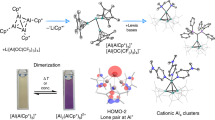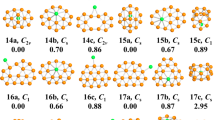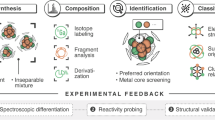Abstract
Molecular species containing metal–metal bonds have been known for a long time1. But these have generally involved transition metals; metal–metal bonds between main-group elements were discovered only more recently2. Within the past decade, polyhedral Al4, Al12 and Ga4 species have all been characterized by X-ray diffraction3,4, and the chemistry of low-valent polynuclear Al species in particular has flourished owing to the development of condensation techniques for preparing them by dispropor-tionation of aluminium monohalides4. By using this approach, we now report the identification and characterization of an Al77 cluster, which is dramatically larger than any seen hitherto and can be considered an intermediate species to the formation of the bulk metal. X-ray diffraction shows that the cluster has a central Al atom surrounded by three concentric polyhedral shells containing 12, 44 and 20 Al atoms. This Al77 core is stabilized by 20 organic ligands, preventing the formation of the bulk metal. Studies of such clusters should provide insights into the crossover between molecular species and the bulk metal for main-group elements.
This is a preview of subscription content, access via your institution
Access options
Subscribe to this journal
Receive 51 print issues and online access
$199.00 per year
only $3.90 per issue
Buy this article
- Purchase on Springer Link
- Instant access to full article PDF
Prices may be subject to local taxes which are calculated during checkout
Similar content being viewed by others
References
Wilson, F. C. & Shoemaker, D. P. X-ray crystallographic data for metal cyclopentadienyl carbonyl compounds. Naturwissenschaften 43, 57–58 (1956).
Uhl, W. Tetrakis[bis(trimethylsilyl)methyl]dialan(4), eine Verbindung mit Aluminium-Aluminium-Bindung. Z. Naturforsch. B 43, 1113–1118 (1988).
Uhl, W. Elementorganische Verbindungen mit Al–Al-, Ga–Ga- und In–In-Bindung. Angew. Chem. 105, 1449–1461 (1993).
Dohmeier, C., Loos, D. & Schnöckel, H. Aluminium(I) and gallium(I) compounds: syntheses, structures and reactions. Angew. Chem. Int. Ed Engl. 35, 129–149 (1996).
Ecker, A. & Schnöckel, H. Donorstabilisiertes Aluminium(I)-iodid. Z. Anorg. Allg. Chem. 622, 149–152 (1996).
Hahn, T. (ed.) International Tables for Crystallography Vol. A 4th edn. (Kluwer Academic, Dordrecht, 1992).
Krautscheid, H., Fenske, D., Baum, G. & Semmelmann, M. Ein neuerKupferselenidcluster mit PPh3 als Ligand: [Cu146Se73(PPh3)30]. Angew. Chem. 105, 1364–1367 (1993).
Ceriotti, A. et al. Synthese und Struktur der Ionen [Ni38Pt6(CO)48H6 _ n]n − (n = 4,5); Ni-Pt-Cluster als molekulare Modelle für “Cherry”-Kristallite. Angew. Chem. 97, 708–710 (1985).
Schmid, G. (ed.) Clusters and Colloids, From Theory to Applications (VCH, Weinheim, 1994).
Kabsch, W. Evaluation of single-crystal-X-ray diffraction data from a position-sensitive detector. J. Appl. Crystallogr. 21, 916–924 (1988).
Sheldrick, G. M. Phase annealing in SHELX-90: direct methods for larger structures. Acta Crystallogr. A 46, 467–473 (1990).
Author information
Authors and Affiliations
Rights and permissions
About this article
Cite this article
Ecker, A., Weckert, E. & Schnöckel, H. Synthesis and structural characterization of an AI77 cluster. Nature 387, 379–381 (1997). https://doi.org/10.1038/387379a0
Received:
Accepted:
Issue Date:
DOI: https://doi.org/10.1038/387379a0
This article is cited by
-
Synthesis of a low-valent Al4+ cluster cation salt
Nature Chemistry (2022)
-
A Keplerian Ag90 nest of Platonic and Archimedean polyhedra in different symmetry groups
Nature Communications (2020)
-
Anion stabilised hypercloso-hexaalane Al6H6
Nature Communications (2018)
-
Chlorine-passivated superatom Al37 clusters for nonlinear optics
Science China Chemistry (2018)
-
Al13@Pt42 Core-Shell Cluster for Oxygen Reduction Reaction
Scientific Reports (2014)
Comments
By submitting a comment you agree to abide by our Terms and Community Guidelines. If you find something abusive or that does not comply with our terms or guidelines please flag it as inappropriate.



